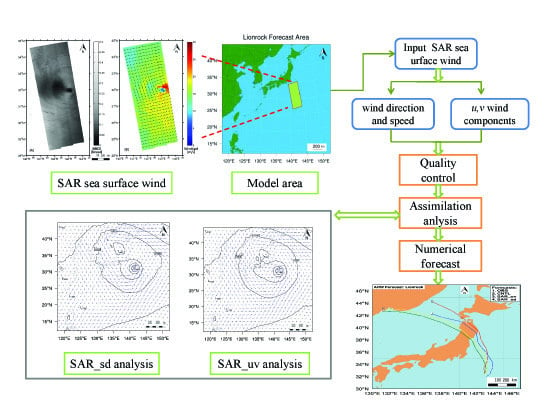Assimilation of Sentinel-1 Derived Sea Surface Winds for Typhoon Forecasting
Abstract
:1. Introduction
2. Data and Methodology
2.1. SAR Wind Retrieval
2.2. Data Assimilationof SAR Sea Surface Winds
2.3. Observation Quality Control Scheme
3. Case Study—Typhoon Lionrock of 2016
3.1. Description of Typhoon Lionrock
3.2. Experimental Design
3.3. Model Description
4. Experimental Results
4.1. Wind Analysis at 10 m
4.2. Analysis Bias at Different Height
4.3. Analysis Increment for Different Analysis Parameters
4.4. Forecast Results
5. Discussion and Conclusions
Acknowledgments
Author Contributions
Conflicts of Interest
References
- Zhang, Y.; Chen, Y.; Zhu, M. Research on ocean surface wind field retrievals from SAR. Electron. Meas. Technol. 2007, 30, 36–38. [Google Scholar]
- Dagestad, K.F.; Horstmann, J.; Mouche, A.; Perrie, W.; Shen, H.; Zhang, B.; Li, X.; Monaldo, F.; Pichel, W.; Lehner, S.; et al. Wind retrieval from synthetic aperture radar-an overview. In Proceedings of the 4th SAR Oceanography Workshop (SEASAR 2012), Tromsø, Norway, 18–22 June 2012. [Google Scholar]
- Chang, R.; Zhu, R.; Badger, M.; Hasager, C.B.; Xing, X. Offshore wind resources assessment from multiple satellite data and WRF modeling over South China Sea. Remote Sens. 2015, 7, 467–487. [Google Scholar] [CrossRef]
- Hasager, C.; Badger, M.; Peña, A.; Larsén, X.; Bingöl, F. SAR-based wind resource statistics in the Baltic Sea. Remote Sens. 2011, 3, 117–144. [Google Scholar] [CrossRef] [Green Version]
- Yu, Y.; Zhang, W.; Wu, Z.; Yang, X.; Cao, X.; Zhu, M. Assimilation of HY-2A scatterometer sea surface wind data in a 3DVAR data assimilation system—A case study of Typhoon Bolaven. Front. Earth Sci. 2015, 92, 192–201. [Google Scholar] [CrossRef]
- Yang, X.; Li, X.; Zheng, Q.; Gu, X.; Pichel, W.G.; Li, Z. Comparison of Ocean-Surface Winds Retrieved From QuikSCAT Scatterometer and Radarsat-1 SAR in Offshore Waters of the U.S. West Coast. IEEE Geosci. Remote Sens. Lett. 2011, 8, 163–167. [Google Scholar] [CrossRef]
- Danielson, R.; Dowd, M.; Ritchie, H. Marine Wind Analysis with the Benefit of Radarsat-1 Synthetic Aperture. In Proceedings of the OceanSAR 2006—Third Workshop on Coastal and Marine Applications of SAR, St. John’s, NL, Canada, 23–25 October 2006. [Google Scholar]
- Geldsetzer, T.; Pogson, L.; Scott, A.; Buehner, M.; Carrieres, T.; Ross, M.; Caya, A. Retrieval of sea ice and open water from SAR imagery for data assimilation. In Proceedings of the 7th IICWG Workshop on Sea Ice Data Assimilation and Verification, Frascati, Italy, 5–7 April 2016. [Google Scholar]
- Lin, H.; Xu, Q.; Zheng, Q. An overview on SAR measurements of sea surface wind. Proc. Nat. Sci. 2008, 18, 913–919. [Google Scholar] [CrossRef]
- Li, X.; Zhang, J.A.; Yang, X.; Pichel, W.G.; DeMaria, M.; Long, D.; Li, Z. Tropical cyclone morphology from spaceborne synthetic aperture radar. Bull. Am. Meteorol. Soc. 2013, 94, 215–230. [Google Scholar] [CrossRef]
- Perrie, W.; Zhang, W.; Bourassa, M.; Shen, H.; Vachon, P.W. Impact of satellite winds on marine wind simulations. Weather Forecast. 2008, 23, 290–303. [Google Scholar] [CrossRef]
- Yang, X.; Li, X.; Pichel, W.G.; Li, Z. Comparison of ocean surface winds from ENVISAT ASAR, MetOp ASCAT scatterometer, buoy measurements, and NOGAPS model. IEEE Trans. Geosci. Remote Sens. 2011, 49, 4743–4750. [Google Scholar] [CrossRef]
- Ahsbahs, T.; Badger, M.; Karagali, I.; Larsén, X. Validation of Sentinel-1A SAR Coastal Wind Speeds against Scanning LiDAR. Remote Sens. 2017, 9, 552. [Google Scholar] [CrossRef]
- Danielson, R.; Fillion, L.; Ritchie, H.; Dowd, M. Assimilation of SAR Wind Information IN Environment Canada’s High Resolution 3D-Var Analysis System. In Proceedings of the Third International Workshop, Frascati, Italy, 25–29 January 2010. [Google Scholar]
- Perrie, W.; Zhang, W.; Bourassa, M.; Shen, H.; Vachon, P.W. SAR-derived Winds from Hurricanes: Assimilative Blending with Weather Forecast Winds. In Proceedings of the Proceedings Ocean SAR 2006, St. John’s, NL, Canada, 1–3 October, 2006. [Google Scholar]
- Choisnard, J.; Laroche, S. Properties of variational data assimilation for synthetic aperture radar wind retrieval. J. Geophys. Res. 2008, 113, C050061-13. [Google Scholar] [CrossRef]
- Barker, D.; Huang, X.Y.; Liu, Z.; Auligné, T.; Zhang, X.; Rugg, S.; Ajjaji, R.; Bourgeois, A.; Bray, J.; Chen, Y.; et al. The weather research and forecasting model’s community variational/ensemble data assimilation system: WRFDA. Bull. Am. Meteorol. Soc. 2012, 93, 831–843. [Google Scholar] [CrossRef]
- Huang, X.Y.; Gao, F.; Jacobs, N.A.; Wang, H. Assimilation of wind speed and direction observations: A new formulation and results from idealized experiments. Tellus A 2013, 65, 19936. [Google Scholar] [CrossRef]
- Gao, F.; Huang, X.Y.; Jacobs, N.A.; Wang, H. Assimilation of wind speed and direction observations: Results from real observation experiments. Tellus A 2015, 67, 27132. [Google Scholar] [CrossRef]
- Li, X. The first Sentinel-1 SAR image of a typhoon. Acta Oceanol. Sin. 2015, 34, 1–2. [Google Scholar] [CrossRef]
- Friedman, K.; Li, X. Storm patterns over the ocean with wide swath SAR. Johns. Hopkins Univ. Appl. Phys. Lab. APL Tech. Dig. 2000, 21, 80–85. [Google Scholar]
- Li, X.; Pichel, W.G.; He, M.; Wu, S.Y.; Friedman, K.S.; Clemente-Colón, P.; Zhao, C. Observation of hurricane-generated ocean swell refraction at the Gulf Stream north wall with the RADARSAT-1 synthetic aperture radar. IEEE Trans. Geosci. Remote Sens. 2002, 40, 2131–2142. [Google Scholar]
- Zhang, G.; Li, X.; Perrie, W.; Hwang, P.A.; Zhang, B.; Yang, X. A Hurricane Wind Speed Retrieval Model for C-Band RADARSAT-2 Cross-Polarization ScanSAR Images. IEEE Trans. Geosci. Remote Sens. 2017, 55, 4766–4774. [Google Scholar] [CrossRef]
- Hersbach, H.; Stoffelen, A.; De Haan, S. An improved C-band scatterometer ocean geophysical model function: CMOD5. J. Geophys. Res. 2007, 112, C030061-18. [Google Scholar] [CrossRef]
- Du, Y.; Vachon, P.W. Characterization of hurricane eyes in RADARSAT-1 images with wavelet analysis. Can. J. Remote Sens. 2003, 29, 491–498. [Google Scholar] [CrossRef]
- Zhou, X.; Yang, X.; Li, Z.; Yu, Y.; Bi, H.; Ma, S.; Li, X. Estimation of tropical cyclone parameters and wind fields from SAR images. Sci. China Earth Sci. 2013, 56, 1977–1987. [Google Scholar] [CrossRef]
- Le Dimet, F.X.; Talagrand, O. Variational algorithms for analysis and assimilation of meteorological observations: Theoretical aspects. Tellus A 1986, 38, 97–110. [Google Scholar] [CrossRef]
- Zou, X.; Navon, I.M.; Sela, J. Control of gravitational oscillations in variational data assimilation. Mon. Weather Rev. 1993, 121, 272–289. [Google Scholar] [CrossRef]
- Barker, D.M.; Huang, W.; Guo, Y.R.; Bourgeois, A.J.; Xiao, Q.N. A three-dimensional variational data assimilation system for MM5: Implementation and initial results. Mon. Weather Rev. 2004, 132, 897–914. [Google Scholar] [CrossRef]
- Huang, X.Y.; Xiao, Q.; Barker, D.M.; Zhang, X.; Michalakes, J.; Huang, W.; Henderson, T.; Bray, J.; Chen, Y.; Ma, Z.; et al. Four-dimensional variational data assimilation for WRF: Formulation and preliminary results. Mon. Weather Rev. 2009, 137, 299–314. [Google Scholar] [CrossRef]
- Velden, C.S.; Hayden, C.M.; Paul Menzel, W.; Franklin, J.L.; Lynch, J.S. The impact of satellite-derived winds on numerical hurricane track forecasting. Weather Forecast. 1992, 7, 107–118. [Google Scholar] [CrossRef]
- Holmlund, K.; Velden, C.S.; Rohn, M. Enhanced automated quality control applied to high-density satellite-derived winds. Mon. Weather Rev. 2001, 129, 517–529. [Google Scholar] [CrossRef]
- Hollingsworth, A.; Lönnberg, P. The statistical structure of short-range forecast errors as determined from radiosonde data. Part I: The wind field. Tellus A 1986, 38, 111–136. [Google Scholar] [CrossRef]
- Raymond, T. Report on TC’s Key Activities and Main Events in the Region 2016. In Proceedings of the 49 Session ESCAP/WMO Typhoon Committee, Yokohama, Japan, 21–24 February, 2017. [Google Scholar]
- Hong, S.Y.; Dudhia, J.; Chen, S.H. A revised approach to ice microphysical processes for the bulk parameterization of clouds and precipitation. Mon. Weather Rev. 2004, 132, 103–120. [Google Scholar] [CrossRef]
- Kain, J.S. The Kain–Fritsch convective parameterization: An update. J. Appl. Meteorol. 2004, 43, 170–181. [Google Scholar] [CrossRef]
- Shin, H.H.; Hong, S.Y. Intercomparison of planetary boundary-layer parametrizations in the WRF model for a single day from CASES-99. Bound. Layer Meteorol. 2011, 139, 261–281. [Google Scholar] [CrossRef]
- Skamarock, W.C.; Klemp, J.B.; Dudhia, J. Prototypes for the WRF (Weather Research and Forecasting) model. Preprints. In Proceedings of the Ninth Conference Mesoscale Processes, American Meteorological Society, Fort Lauderdale, FL, USA, 11–15 July 2001. [Google Scholar]
- Mejia, J.F.; Murillo, J.; Galvez, J.M.; Douglas, M.W. Accuracy of the NCAR global tropospheric analysis (FNL) over Central South America based upon upper air observations collected during the SALLJEX. In Proceedings of the 8th International Conference on Southern Hemisphere Meteorology and Oceanography (ICSHMO), Foz do Iguaçu, Brazil, 24–28 April 2006. [Google Scholar]
- Xu, D.; Liu, Z.; Huang, X.Y.; Min, J.; Wang, H. Impact of assimilating IASI radiance observations on forecasts of two tropical cyclones. Meteorol. Atmos. Phys. 2013, 122, 1–18. [Google Scholar] [CrossRef]
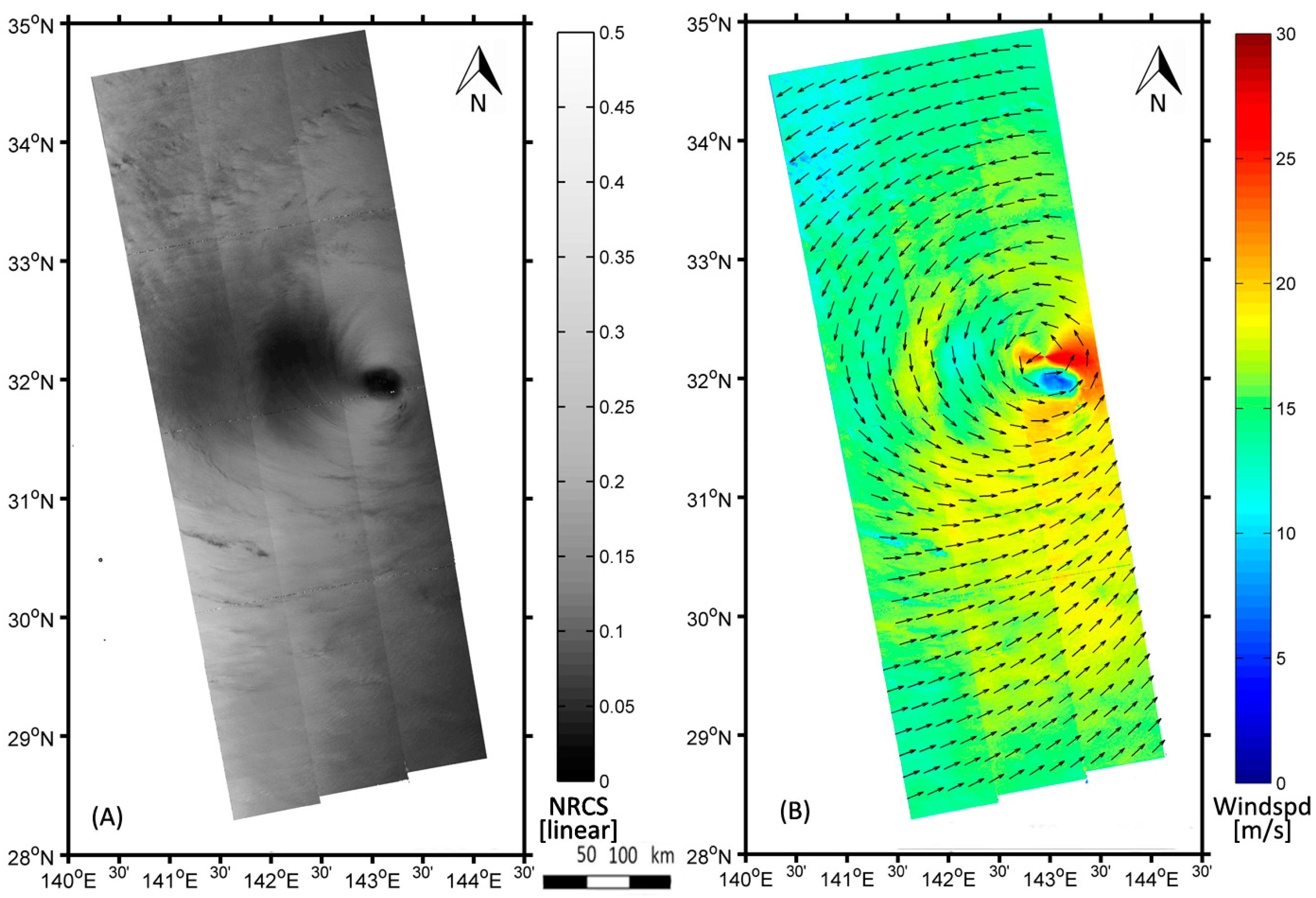
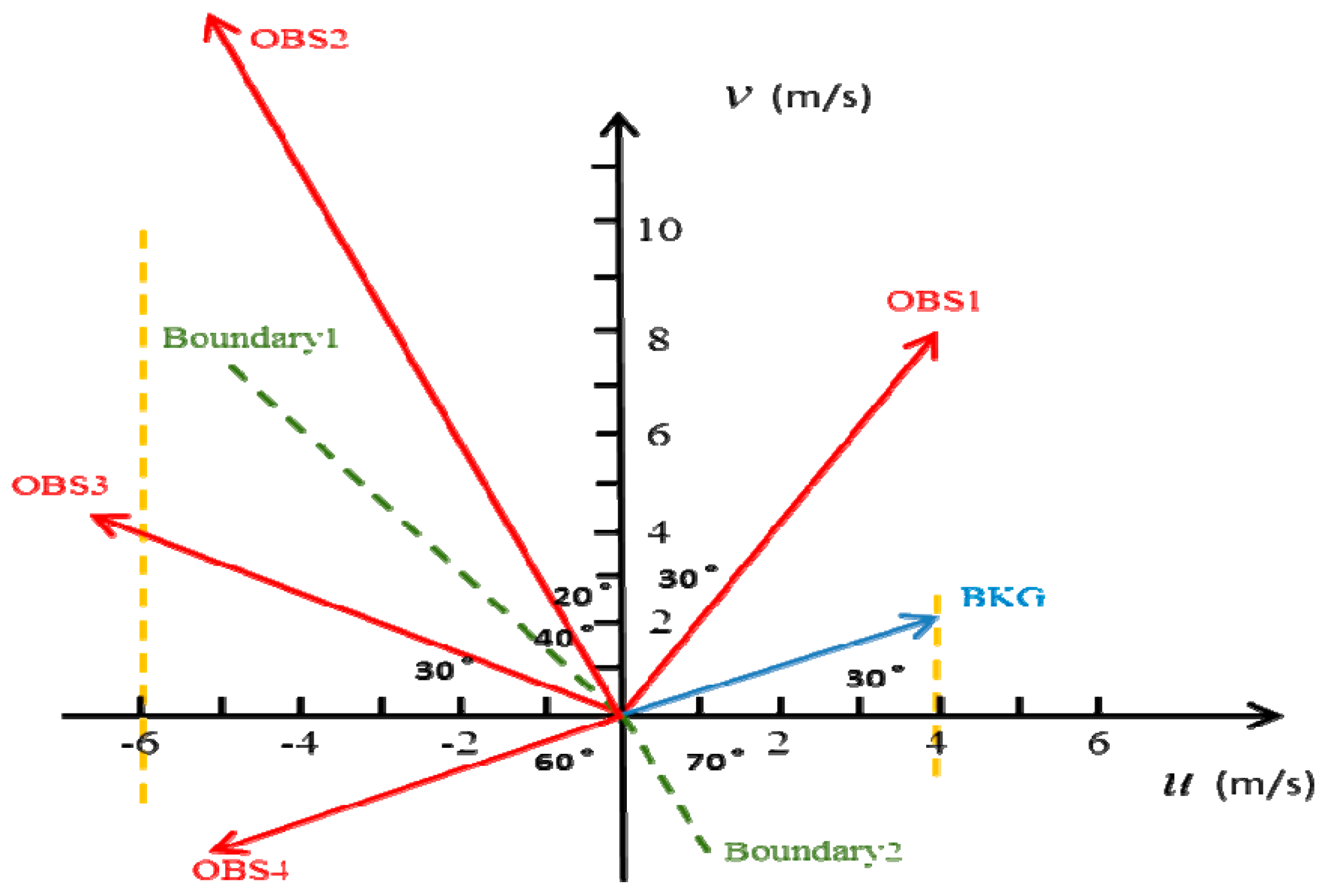

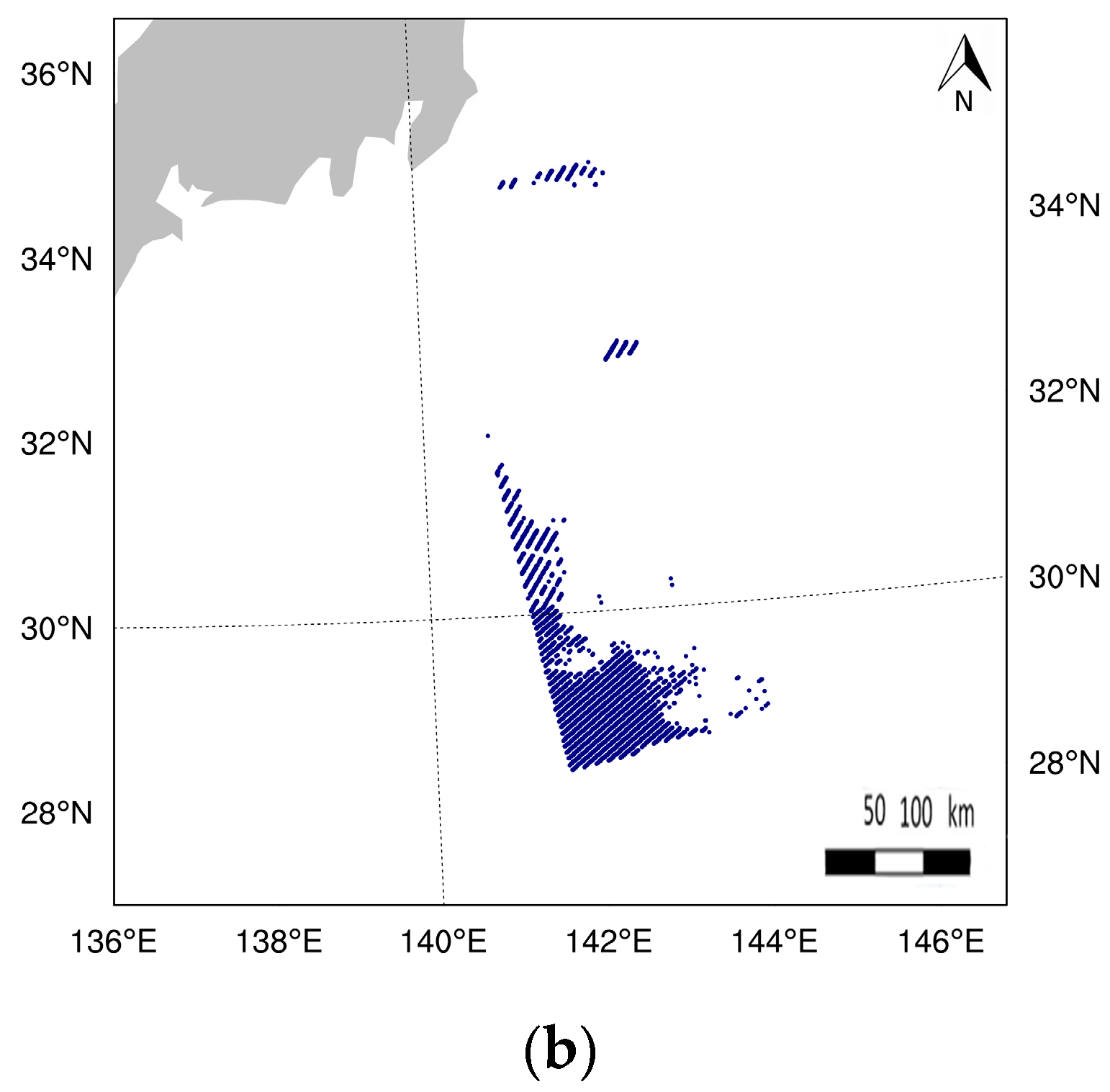
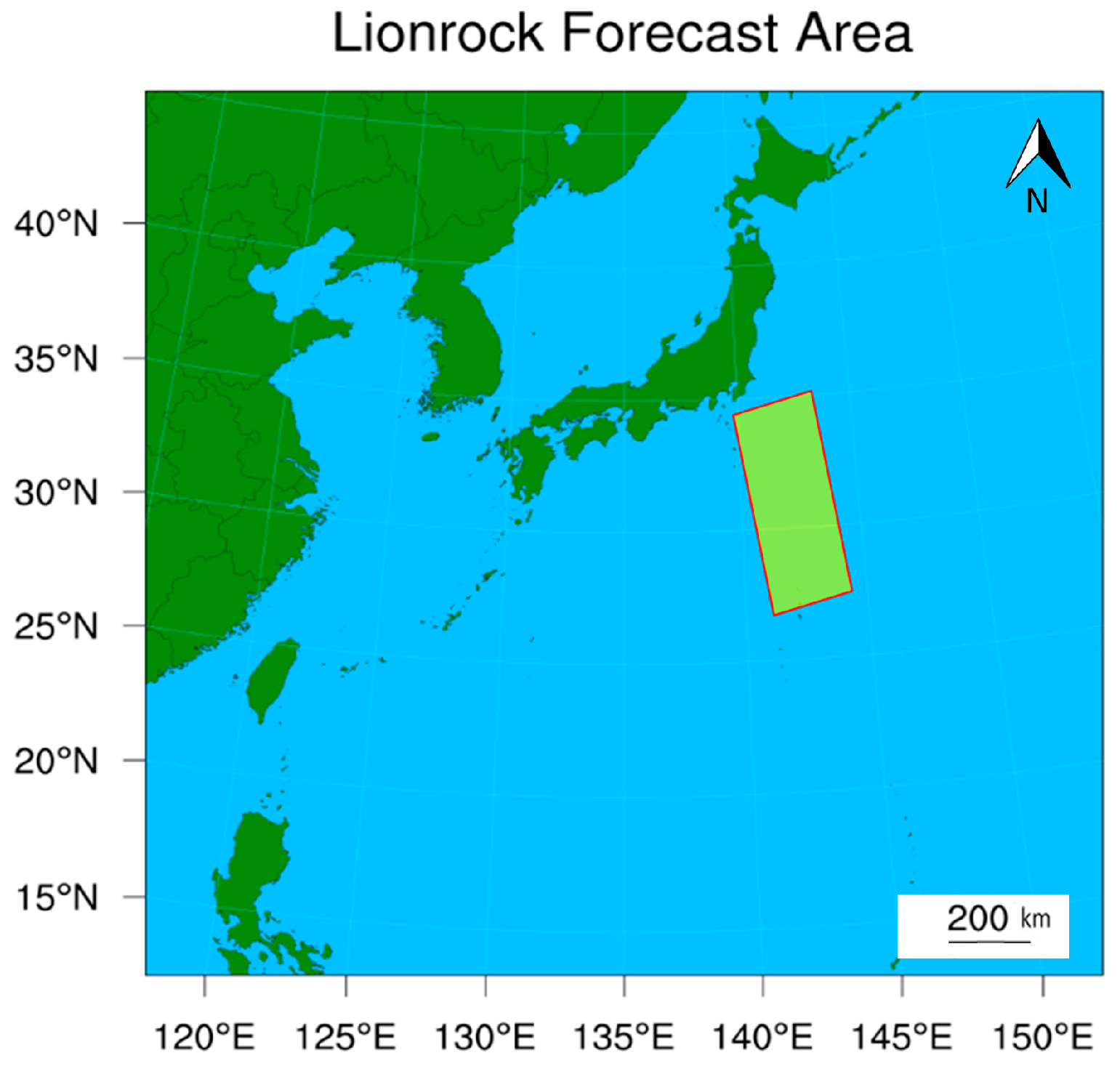
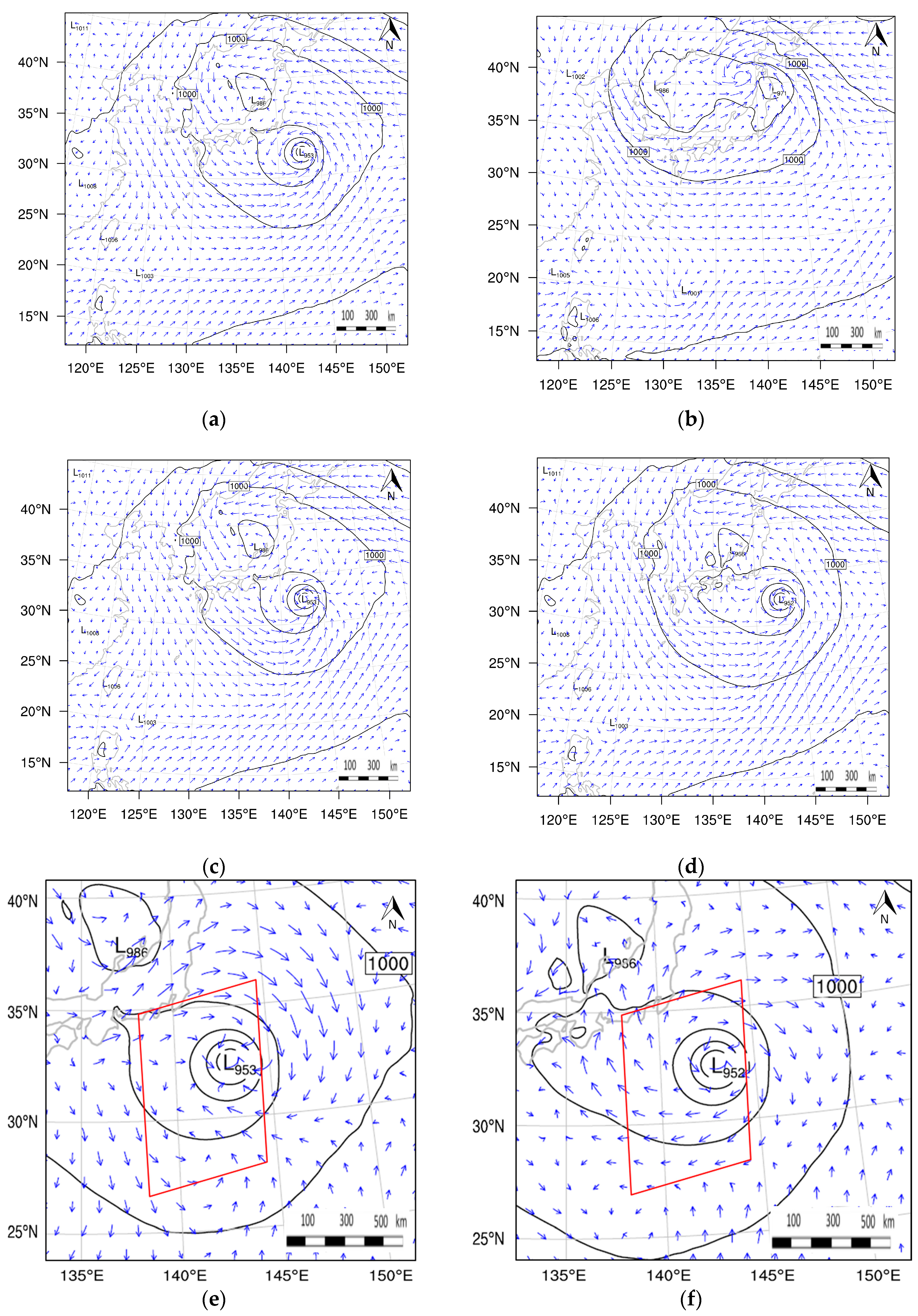
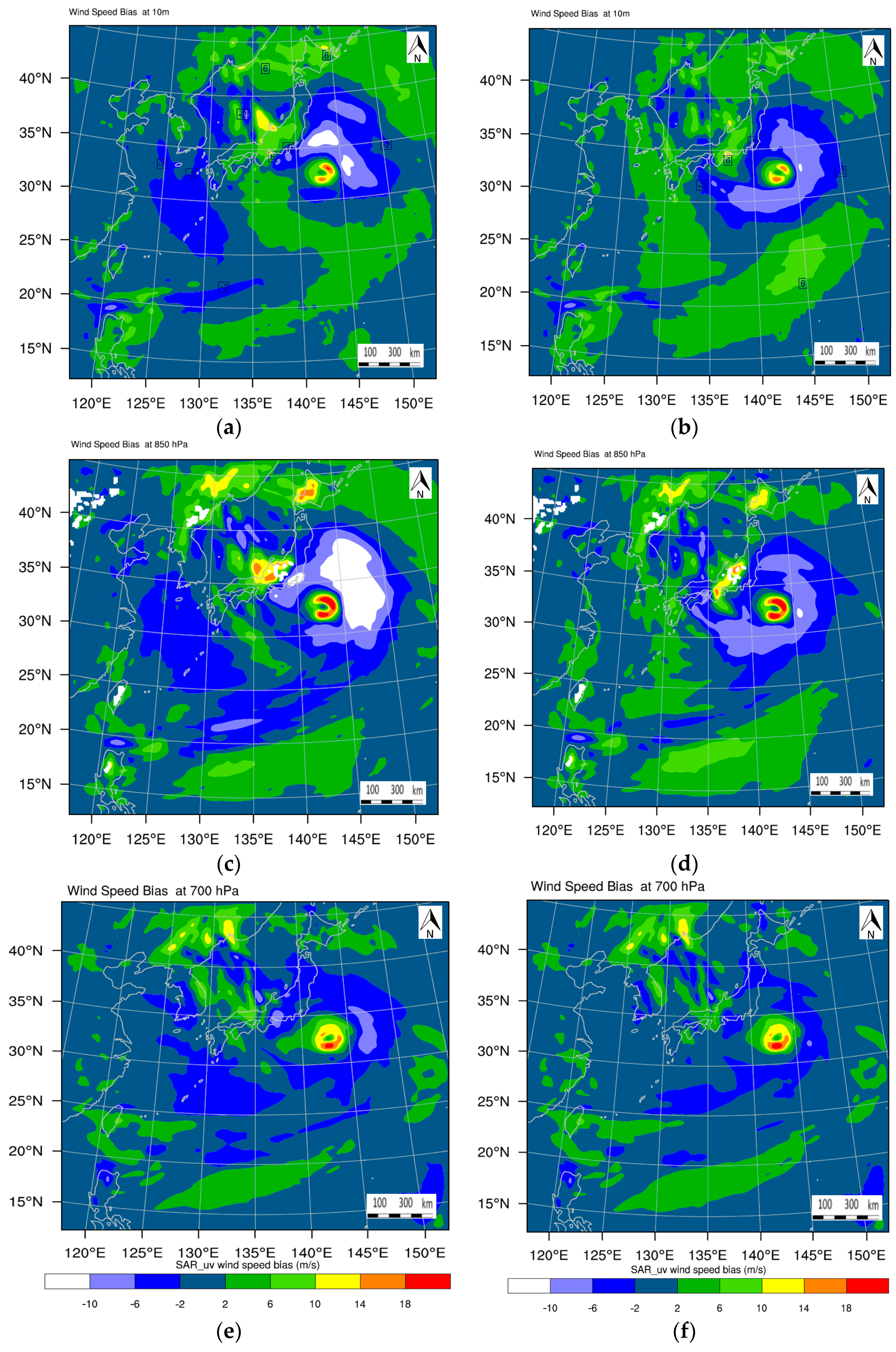
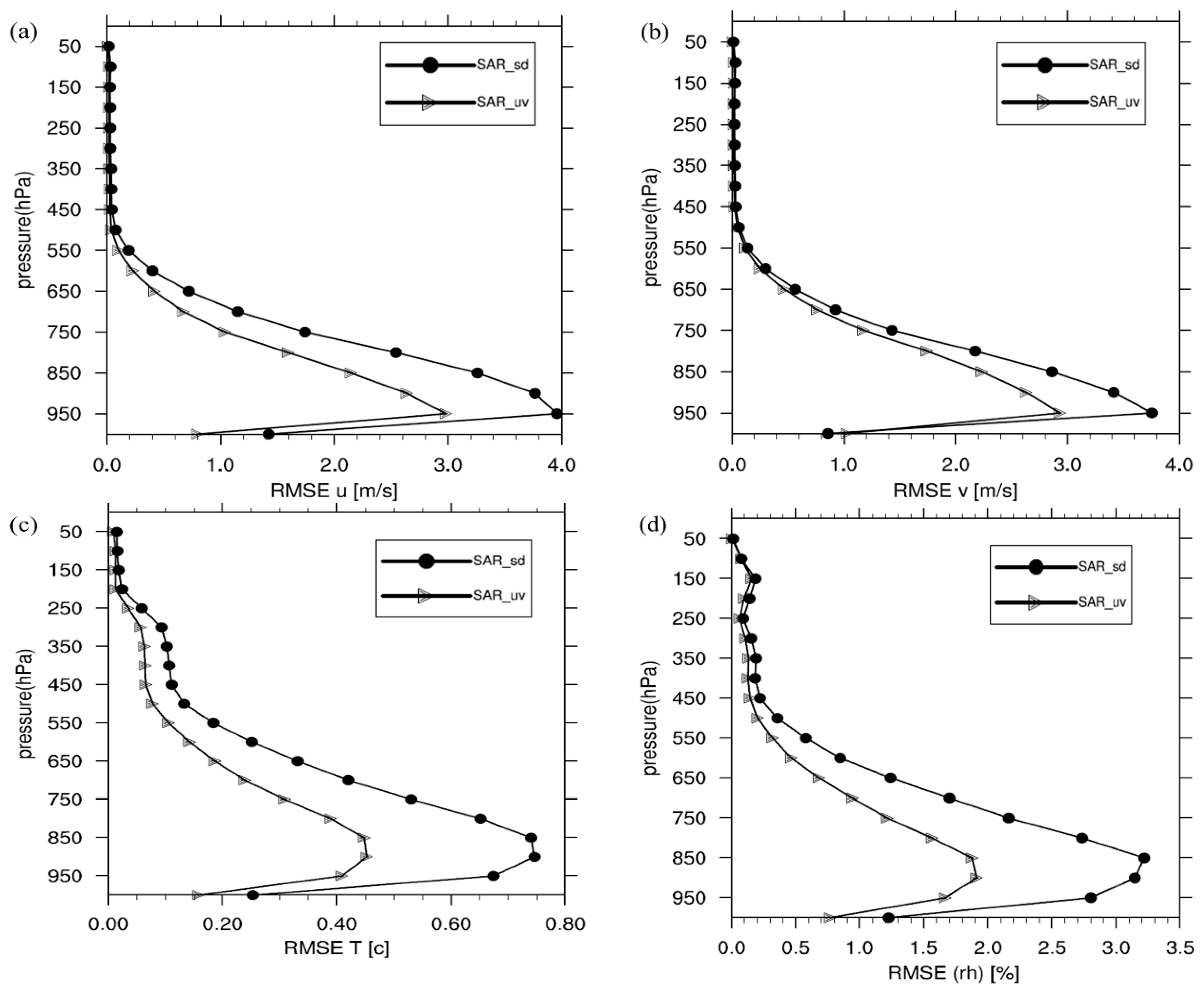

| Wind Vectors | Spd (m/s) | Dir (°) | U (m/s) | V (m/s) |
|---|---|---|---|---|
| BKG | 4.61 | 30 | 4.00 | 2.31 |
| OBS1 | 8.00 | 60 | 4.00 | 6.93 |
| OBS2 | 14.62 | 110 | −4.99 | 13.74 |
| OBS3 | 6.80 | 150 | −5.89 | 3.40 |
| OBS4 | 5.60 | 210 | −4.85 | −2.80 |
| Observation Types | SAR_sd | SAR_uv | ||
|---|---|---|---|---|
| QC_co | QC_al | QC_co | QC_al | |
| OBS1 | spd, dir | spd, dir | u, v | u, v |
| OBS2 | - | dir | - | u |
| OBS3 | - | spd | - | v |
| OBS4 | - | spd | u, v | u, v |
| Experiment | Data | Operator | Quanlity Controll | Accept Obs. | Reject Obs. |
|---|---|---|---|---|---|
| CNTL | - | - | - | - | - |
| SAR_uv | u and v componets | UV operator | QC_co | 2896 | 20,311 |
| SAR_sd | spd and dir | SD operator | QC_co | 327 | 22,880 |
© 2017 by the authors. Licensee MDPI, Basel, Switzerland. This article is an open access article distributed under the terms and conditions of the Creative Commons Attribution (CC BY) license (http://creativecommons.org/licenses/by/4.0/).
Share and Cite
Yu, Y.; Yang, X.; Zhang, W.; Duan, B.; Cao, X.; Leng, H. Assimilation of Sentinel-1 Derived Sea Surface Winds for Typhoon Forecasting. Remote Sens. 2017, 9, 845. https://doi.org/10.3390/rs9080845
Yu Y, Yang X, Zhang W, Duan B, Cao X, Leng H. Assimilation of Sentinel-1 Derived Sea Surface Winds for Typhoon Forecasting. Remote Sensing. 2017; 9(8):845. https://doi.org/10.3390/rs9080845
Chicago/Turabian StyleYu, Yi, Xiaofeng Yang, Weimin Zhang, Boheng Duan, Xiaoqun Cao, and Hongze Leng. 2017. "Assimilation of Sentinel-1 Derived Sea Surface Winds for Typhoon Forecasting" Remote Sensing 9, no. 8: 845. https://doi.org/10.3390/rs9080845





